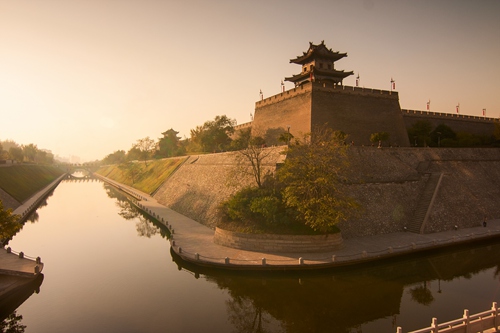Xi'an City Wall: ancient defense system
(chinadaily.com.cn) Updated: 2016-06-27 11:44
 |
|
The southeast corner of the City Wall in Xi’an city, Shaanxi province. [Photo provided to chinadaily.com.cn] |
Construction on the wall began in 194 BC and lasted four years. Construction on the existing wall started during the Ming Dynasty in 1370. It encircles 14 square kilometers of the city.
After the establishment of the Ming Dynasty (1368-1644) by its first emperor, Zhu Yuanzhang, work began to enlarge the initially wall built in the Tang Dynasty (AD 618-907), creating the modern Xi'an City Wall as we know it today.
The wall was extended to be 12 meters tall, 12-14 meters wide at the top and 15-18 meters wide at the bottom. It covers 13.7 kilometers (8.5 miles) in length and was surrounded by a deep moat.
 |
| Xi’an City Wall has seen many changes over the years. [Photo provided to China Daily] |
Ramparts (98 in total) were built every 120 meters along the wall, extending out from the main wall. They were built to defend against enemy invasions, should attempts to scale the wall be made. Each rampart has a sentry building in which soldiers could protect the entire wall without exposing themselves to the enemy. On the outer side of the city wall, there are 5,948 battlements, allowing soldiers to look out and shoot at the enemy. On the inner side of the wall, parapets were built to protect soldiers from falling off.
The city wall includes four major gates: Changle (meaning eternal joy) in the east, Anding (harmony peace) in the west, Yongning (eternal peace) in the south and Anyuan (forever harmony) in the north. The south gate is the most beautifully decorated of the four and is located close to the Bell Tower in the then center of the city. Important greeting ceremonies organized by the Provincial Government are often held at the square located at the south gate.
A circular park has been built along the high wall and the deep moat. The thriving trees and flowers decorate the classical Chinese architecture of the wall, adding additional beauty to the very ancient.
 |
|
The city wall was a state-of-the-art military fortress at the time of its construction.[Photo provided to chinadaily.com.cn] |
- Joint boost pledged for world peace
- China to recruit lawyers, legal experts to draft bills
- Lack of tents, shelter for Funing tornado victims
- Rocket takes China closer to space station
- What you need to know about Jiangsu's deadly tornado
- China faces challenges in tornado forecast: weather authority
- Ruling may 'open Pandora's box'
- Poverty funds facing stiffer supervision
- Guns a growing factor in narcotics enforcement
- China issues disaster alerts





